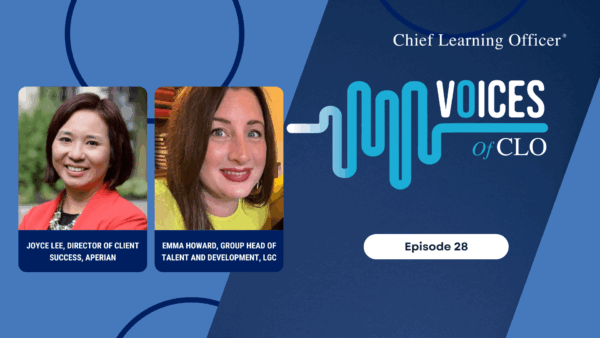Superheroes inspire people by the work they do and by the personal barriers they overcome. They successfully face challenges and dedicate their lives to saving and bettering the world around them.
Jenny Dearborn, chief learning officer for software company SAP, has had a longstanding affection for superheroes. She used comic books to learn how to read despite a series of undiagnosed learning disabilities. “The selflessness, the sense of justice and self-sacrifice, the doing what’s right for the greater good and being the underdog, and all of the values around superheroes really speak to my core,” Dearborn, 46, said.
At home, Dearborn paints giant canvases of her favorite heroes for stress relief. And since entering the workforce development profession, she has come to the rescue for multiple companies in need of her assistance. Like the best superheroes, she doesn’t see her work as heroic but as using her abilities to help others.
“I don’t think I bring any kind of magic epiphany,” she said. “I think when the student is ready, the teacher will appear.”
And so she did — but only after she had conquered her personal villains.
Disorderly Advantage
When Dearborn was growing up, she wasn’t sure what she wanted to be. Trick skateboarding was on the list. “The Pink Panther” movies provoked interest in military espionage. For a brief time, she even pursued acting and modeling in New York.
There was one problem — she couldn’t read basic content until she was in sixth grade. Only when she started attending and working at a community college’s front office did someone recommend she get tested.
Despite scoring high in intelligence, Dearborn had some clear learning disabilities. As a young adult, she was diagnosed with acute dyslexia, attention deficit and hyperactivity disorder and obsessive compulsive disorder.
“To take a gifted kid, tell them they’re retarded, put them in special ed and tell them that you’ll never be anything but a pretty face and you’ll be lucky to get a husband who can take care of you — who would do that to a child?” she said. “I was just so angry, and it took me a long time to turn that energy into making the world a better place as opposed to being ready to snap at anybody.”
Dearborn found ways to function beyond the diagnosed barriers. It takes her longer to read because of her dyslexia, so she takes in content through audio recordings. Her staff makes sure papers are immaculate so she doesn’t obsess over uneven spacing or punctuation errors.
She has also used her disorders to her advantage. To her, the hairier the dilemma, the more likely she’ll be engaged. Despite coaching that told her early in her career that she jumps around too much, Dearborn embraces her ability to fix something and hand it over to someone — and the companies she has worked with have benefited from it.
“People with dyslexia view things in different ways, and they prefer challenges,” said Ben Shifrin, head of the Jemicy School for Dyslexics and vice president of the International Dyslexia Association. “They are global thinkers and not so much logistical thinkers. Dyslexics can come up with big picture concepts and work well in teams, but they may need help with organization and are not good at mundane tasks.”
Luckily, nothing would be mundane about Dearborn’s future.
Prove It
Dearborn’s life and career have revolved around her mantra: “Prove it.”
“I wanted to prove that I could overcome this thing I had learned about myself,” she said. “What could I pick that would be the hardest possible thing that I could do to prove to myself that I was stronger than this diagnosis?”
The answer: teaching high school English.
After getting her degree and spending two years in the classroom, Dearborn realized teaching “Romeo and Juliet” each semester wasn’t what she wanted. She started watching VHS tapes of interviews with former teachers who had gone on to other careers. Corporate education caught her attention.
After researching the industry and deciding she wanted to stay in Silicon Valley, Dearborn started interviewing at the Hewlett-Packard Co., where her father-in-law worked. Between September and June, she had 36 informational interviews in-person with different employees. By the end of her tour, she had a job offer.
“I graduated my seniors on June 16, and I started my first day on Monday, June 19,” she said. “I had an offer and everything, and it was because I kept exploring.”
Within a week, she was teaching a “Welcome to Hewlett-Packard” course to classes of 50 new hires. She taught other classes before moving into management. Over the next four years, she moved from services to software to sales and support and different education groups within the organization.
She left to become director of education for learning management startup Docent Inc., now known as SumTotal Systems Inc. After that came Sun Microsystems, where she created learning for employees and customers alike as senior manager of training and development and then chief learning architect between 2003 and 2007.
After a brief return to HP as a senior director of learning for technology services, global sales and enterprise marketing, and corporate learning and development strategy, Dearborn was recruited by human capital management software company SuccessFactors.
“I was not hired to make sure employees are happy, that everyone gets 40 hours a year of training or to switch the consumption model from instructor-led to e-learning,” she said. “The only thing I was asked to do when I was hired was to fix business metrics.”
The company’s attrition rate was nearly four times as high as industry standards. Some 70 percent of the sales force wasn’t bringing in any revenue, while a small group brought in triple- or quadruple-digit percentages of their quotas.
Dearborn brought in psychologists to help identify what top performers did differently from bottom performers, matching the findings — personality, behavior, skills, etc. — to a revised boot camp class she delivered to SuccessFactors’ sales team.
Coming to SAP’s Rescue
Less than a year after Dearborn joined SuccessFactors, SAP acquired the company. The software company had about 65 separate corporate learning teams, but Dearborn wasn’t interested in being No. 66.
“Either I’m going to clean up the whole thing, which I love to do — the bigger the hairball the better — or I’m going to politely step away and find something else to do at another company,” she said.
One day SAP’s CEO, Bill McDermott, happened to be in her office, unannounced and entourage-free.
“He was making a beeline to the men’s room, and I literally jumped in front of him and blocked his path,” she said. She introduced herself as SuccessFactors’ chief learning officer and offered to take the same position for SAP as a whole. He asked her to put together a proposal for the board. She did, and they appointed her to be the company’s first CLO.
Like SuccessFactors, SAP had a learning problem when Dearborn came on board. Of its 75,000 employees, 7,500 are people managers. Originally, these employees had to travel to Waldorf, Germany, or New Town Square, Pennsylvania, and pay thousands of dollars out of their budgets to get basic manager skills training — a barrier that left successive generations of managers untrained and dangerous to the company’s success.
“It’s cruel to hire people and not give them the tools and resources they need to be amazing,” Dearborn said.
She said she wanted to get rid of the double standard that SAP put forward by placing importance on learning but making it hard to access. Since the beginning of 2015, management training is free and trainers travel to managers, not the other way around. By 2016, she wants all 7,500 managers to have experienced the program.
During Dearborn’s first month on the job, Stefan Ries returned to the company as SAP’s chief human resource officer. Since April 2014, they’ve worked hand-in-hand on some of the major global challenges that thwart its transition into a fully cloud-based company.
“Business transformation, especially when you have a CLO in your organization, plays a very important role,” Ries said. “She has to be the enabler, and at the same time also the role model.”
By broadening leadership and management learning programs’ reach, Dearborn enabled and modeled the principles that guide SAP’s learning culture. The organization’s motto, “Run Simple,” encourages open debate and discussion over what’s working and how her department could work better.
“When you have been a very successful company in the past, to make the people believe we need to change for the better, it’s very hard,” Ries said. “But when you can prove it, when you go out there with very ambitious goals and deliver against them, that’s when people follow you.”
The Metrics Justify the Ends
Justifying and inciting change in an engineering organization like SAP requires hard metrics. Dearborn would argue that’s the case for CLOs in general. “As a learning professional, if you can’t provision your program without affecting those metrics that an executive thinks about, then you really shouldn’t be having this conversation,” she said. “If you can’t speak that language, you’re out of your league.”
Dearborn connects with leaders to learn what metrics they’re most worried about, then uses that information to justify the need for her work. She has been successful, too — in the last year and a half, SAP reassessed more than $28 million to renovate, revitalize and relaunch the new management program.
She used the same evidential method when at SuccessFactors, where she opened sales boot camps by delivering data that showed how actively participating in the training helped sales people make their quota.
But not everything is numbers. “If you do a sales development program, you can see the changes within two quarters in sales metrics,” Dearborn said. “But in leadership development, sometimes the metrics are harder to get in real time because some of the surveys are annual.”
Dearborn said she sees evidence of her success through the palpable shift in leadership engagement. Managers are on campus more and engage in conversations about employee development in ways they never have before. They want to know what they can do to get involved, such as teach classes.
Unlike financial departments that only have so many ways to approach a task, learning leaders deal with flexible definitions of development, leadership and talent. Ries said the HR function is measured on simplicity, standardization and customer satisfaction.
“You always have to do that from the heart of the business,” he said. “We spend so much money — what’s the outcome of it, and how are we going to use it to innovate our products and services?”
Superheroes Don’t Retire
Dearborn plans to dive deep into learning technology. Although SAP has used massive open online courses, or MOOCs, she wants to deploy more blended solutions and deliver a greater variety of modalities. She also wants to boost informal learning by putting in rotation programs for high potential employees by moving them between business units and countries.
SAP’s coaching practice, which won the 2015 Prism Award from the International Coaching Federation, is also on her to-do list. Her goal is to get 1 percent, or 750, of SAP employees externally certified as coaches. With 350 already in the practice, she’s almost halfway there.
But when all of the learning-based crises at SAP are fixed, what will Dearborn do? She’s still interested in improving the country’s education system so children with learning disabilities don’t go through the same ordeal she did. She’s also interested in world events and humanitarian projects.
“I don’t plan on ever retiring,” she said. “I hope to continue to grow and make an even greater impact, to go from tens of thousands of customers to hundreds of thousands of customers to millions of customers. When I say customers, I mean learners — people who are consuming the learning intervention that I can help bring into fruition.”
Superheroes inspire people by the work they do and by the personal barriers they overcome. They successfully face challenges and dedicate their lives to saving and bettering the world around them.

















